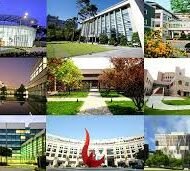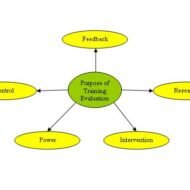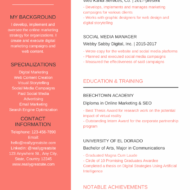Posted by Managementguru in Video Lecturers
on Aug 20th, 2014 | 0 comments

Know the secrets and tips to personality development, positive attitude and gaining unshakable confidence. ...

Posted by Managementguru in B-Schools, Strategy
on Jul 14th, 2014 | 0 comments

Making It to B-School of Your Choice Without having the right knowledge, right from preparing for competitive exams through filling out applications and landing on the right business school, might prove to be a tough journey. This article focuses on throwing some light on the pre-requisites and procedures involved in applying for B-Schools… In Case you have admits from multiple business schools, what will be the criteria of selection? Teaching methodology Approach Reputation or Brand value Specializations on offer Location Please understand that every business school has its own strength and it is up to you to go for the one that best suits your needs and budget. Now let us look at some of the pre-requisites needed for admission into B-Schools. Academics: 1. Undergraduate or Graduate GPA (Graded Point Average) 2. Academic Excellence 3. GMAT score Work Experience: You level of performance at work speaks for you during your admission. Business schools love to know about your career advancement, leadership qualities, various positions handled and the ability to handle a group. Goals: Try to chart out a list of goals which are in line with what the school has to offer in order to facilitate your position in the job market after the course. Extracurricular activities: Those qualities that you have developed and specialized over a period of time will distinguish you from the rest of the pool and give you an edge. Say, if you are an extempore speaker, you stand a chance to impress your interviewers in GD (group discussion). GMAT Preparation: You need a systemized study plan and practice Aim for a high GMAT score to secure your admission Get yourself enrolled in a reputed coaching center Filling out Applications: You should take some professional help when it comes to strengthening your resume and create poignant #essays to catch the attention of admission committees. Social media has its say to help you find a professional coach and having a fruitful conversation. Interview stage: This by far is an achievement in itself, especially if you are planning to go abroad. Call for an interview implies that the admission committee is impressed with your profile and keen to know more about you. You should research on interview experiences of past students and seek feedback from a trusted friend or a professional coach. A wait list may come as a rude shock but you need not lose hope. Try to follow the instructions stated by the school and go for additional recommendations if they encourage you to update them with changes in your profile. Handling Rejects: Connect with the associated person in the admission office to know the reason for rejection. Work on those weak areas and revise your plan. Gear up to beat the competition and never lose hope. Connecting with an Overseas Educational Consultant: This will help you in knowing the procedures pertaining to each institution of your choice. You would have heard of SOP – Statement of Purpose which is the key to getting admission or visa even if your academic averages are below par. A consultant comes into picture when you have zero knowledge about international application process, visa application, SOP, passport clearance, visa medicals and so on… AK CONSULTANTS – THE CAREER DESIGNERS It might be a little overwhelming if you don’t have a supporting hand because there will be lot of application filling and email transactions back and forth. The author Shyama Shankar is an expert academic content writer on business and management. Being a HR specialist, She likes to supplement information on job interviews, compensation, entrepreneurship and motivation to the readers. The following infographic gives you a clear idea on the...

Posted by Managementguru in Business Management, Change management, Human Resource, Training & Development
on Apr 25th, 2014 | 0 comments

The process of Training Programme Evaluation Evaluation of training programme is basically critical examination of appraisal of training programmers. Appraisal of training programme is necessary for improvement and evaluation is a continuous process. “Learning from mistakes” and transforming them into experience and knowledge is the crux of training evaluation. Areas of Evaluation: The participant’s opinion about the programme Knowledge, attitude, skills learned during the training sessions Behavioral change, if any, as a result of training Pay off and benefits that accrue to the organization resulting from the change in behavior of the trainees. What should the evaluation process consider in the planning stage? Attributes of training programme to be evaluated Standard for evaluation Measuring various aspects of the programme and feedback on the effectiveness of the same Implementation of the programme results Scrutinizing the changes that need to be done in the training session Method of dealing with the change – Who will do it, how will the changes be made, how quickly the changes can be implemented. Steps in the Evaluation Process: Establish acceptable standards and bench marking Data collection Analysis of data, interpretation and drawing conclusions Feedback of the results 1. Establish acceptable standards Standards may be set in any one of the following methods; Setting standards through best practice Setting standards through bench marking 2. Data Collection Data may be collected using any one of the following techniques: Questionnaire Interview Written Test Observation 3. Analysis of Data and Interpretation Raw data should be tabulated – Histogram and frequency distribution yield basic information on the shape of dispersal of data around the mean and standard deviation. Relevant statistical tools must be employed depending upon the purpose of evaluation. 4. Evaluating and Feedback The steps involved in this process are: Design valuation – Includes clear objectives backed up by proper content Evaluation of content – Value and usefulness of the programme content may be measured by seeing the reaction of the trainees. An animated discussion in the classroom is a clear indication of the value the content offers. Usefulness may be known by interviewing the trainees and by comparing the performance impact of training with individual job descriptions. Evaluating the presenters – By taking feedback from the trainees the training quality of the presenter or lecturer may be evaluated. Evaluation of trainees – Three aspects that have to be considered on the part of the trainees are, feeling and opinion, learning and attitudinal changes. Evaluating on the job results and productivity changes – A number of factors affect productivity and pre and post measurement of some of the below mentioned aspects shall throw light on the effect of the training programme. Factors affecting Productivity: Cost Reduction ,grievance reduction, productivity after versus before training, work quality, quantitative results, accident rates, absenteeism, employee suggestions, supervisory rating, profits, sales volume, turnover rates, customer complaints, worker efficiency, training time required for proficiency, cost per untrained employee, new product development, new customers and public relations. Behavioral Factors: Some of the specific behavioral changes listed as follows can be observed before and after the training programme – application of new knowledge, use of new skills, high standards, courtesy, adherence to safety regulations, teamwork, perseverance, honesty, co-operation, quality of work, punctuality, effort, initiative. Useful Information: Sample Training Evaluation Questionnaire 5 evaluation methods to evaluate staff training...

Posted by Managementguru in Resume Samples, Video Lecturers
on Apr 19th, 2014 | 0 comments

Creative Resume Writing A creative resume is a powerful tool that allows you to showcase your unique skills, experiences, and personality in a visually appealing and memorable way. By breaking away from the traditional format, you can captivate potential employers and stand out from the competition. To create a creative resume, begin by identifying your key strengths and achievements, then brainstorm creative ways to present them visually. Consider incorporating elements like color, graphics, and typography that align with your personal brand. Additionally, focus on crafting a compelling narrative that highlights your passion and demonstrates your suitability for the desired role. Have a look at the following resume. It sounds very professional and has all the necessary skills outlined and highlighted in a crisp manner. This is how your resume should be. Tips to Write a Creative Resume Think like the employer Understand what the employer wants and customize your information to address those requirements specifically. Choose a basic font Go for a 11 or 12 font size and use Arial or Times New Roman, that will give a professional look and also legible. Write a custom resume for every job When applying for jobs that are a perfect match for your qualifications and experience. No picture please If the company wants to see your face they shall very well visit your LinkedIn Profile. Review resume examples before you start Before you start work on writing or updating your resume, review resume examples that fit a variety of employment situations. Alternatively take a look at this creative resume. The candidate is a model, so featuring her profile with a photo becomes inevitable. Tricks to Impress Your Employer Keep it clean A recruiter or hiring manager may only see your resume for 15 to 30 seconds, so don’t give them a second thought. Create Social Proof When a potential employer googles your name, they must understand what other think of you. Get feedback from employers If the employer agrees to give you feedback, he most probably will accept your request for a visit to the office. Associate with big brands By associating yourself with the right kind of people and brands, you will develop the kind of authority that will stand out to employers. Show off why you are a perfect fit for the role Organize and customize your resume to highlight your transferable skills and experience, so they can tell in 10 seconds that you are qualified. Resume writing need not be a scary thing, because who will better understand yourself other than you? Note: All the names and positions, company names given in the resume are...

Posted by Managementguru in Interview Questions, Resume Samples
on Apr 6th, 2014 | 0 comments

Resume for Sales Know the purpose of your resume Need help in creating or updating your resume? It certainly can be a tough task because your resume is going to be reviewed by software as well as by hiring managers. This new column brings you top resume tips for choosing a resume format, selecting a resume font, customizing your resume, using resume keywords, explaining employment gaps, and more tips for writing interview winning resumes. Try to understand that the purpose of building your resume is to land an interview and make it as precise as possible and impress the recruiters with your profile. Business and Marketing Writing A great resume is one that highlights your strengths and emphasizes the highs of your career. It is imperative for every professional to get his resume periodically updated to move up the corporate ladder. A resume has four sections: Personal Information. This includes your full name, city, contact number, e-mail address and social media profiles. Your personal information can appear at the top center part of the resume with a header positioned below it. Employment History. Your work history must be arranged beginning from current or most recent employer. It must indicate your designation, inclusive dates of employment and a description of your scope of responsibilities. Educational Attainment. This should also be arranged according to highest level of education attained. Details should include degree earned, inclusive dates and relevant awards or achievements. You do not have to include information from secondary education and earlier. Special Skills. This section is where you highlight core competencies and other skills you have that are relevant to the job opening. What are the key ingredients of a great resume? A sparkling profile with sufficient emphasis on your key strengths. A cover letter that guarantees a personal interview. Customized and tailor-made resumes. Designed by skilled resume writing experts. Professional formatting and layout. What should be there in a profile statement? Understand that highlighting your skills and experience in your profile is the “Catch Point” to impress your new recruiters. Financial Planning and Strategy, Marketing Concepts, Positioning, People Management, Territory Management, Sales Planning, Competitive Analysis, Understanding the Customer, Product Development, Client Relationships, Creative Services are some of the criteria that make a marketing/sales manager stand out from the crowd. Try to bring out the achievements in your career till date and who might be the better master to do it other than yourself! Q: What’s the most common resume mistake? A: Making too many general claims and using too much industry jargon that does not market the candidate. A resume is a marketing document designed to sell your skills and strengths rather than just portray a bio of the candidate. For unemployed candidates, handing out resumes should be a full-time job. The majority of mid- to senior-level positions are filled through networking, so contact absolutely everyone you know in addition to recruiters who are in a position to hire you or share...









